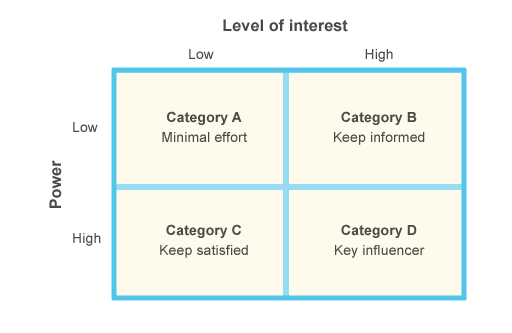3.3 Mapping stakeholders’ power and interest
Read the extract below on power and interest mapping. This is adapted from work by Claire Capon, a leading writer on strategic management. As you read consider into which category each of the three stakeholders from the previous articles – the FA, the owner (Assem Allum) and the fans – falls.
Power and interest mapping
Power and interest mapping is a tool to help you explore the influence that each organisational stakeholder might have. It provides a way of considering the reactions and position of stakeholders when a particular new strategy or course of action is to be introduced (as in the Hull City example). Once you had identified your stakeholders you would map each of them onto the matrix in Figure 9.
Stakeholders with high power and high interest (category D)
Stakeholders with high power and high interest are key influencers in the organisation and are often involved in managing the organisation and its future. If key influencers are not directly involved in managing the organisation, it is vital that they are given serious input in the development of long-term plans and the future direction of the organisation, as they have the power to block proposed plans and implement their own agenda.
Stakeholders with high power and low interest (category C)
Stakeholders with high power and low interest are those who must be kept satisfied, such as institutional shareholders. Institutional shareholders will often remain compliant while they receive acceptable returns on their investment and are satisfied with the organisation’s management and activities. However, the ability of category C stakeholders to reposition themselves towards category D and increase in their level of interest should not be underestimated.
Stakeholders with low power and high interest (category B)
The stakeholders in category B are those with low power and high interest, who are able to exert relatively little power in influencing the organisation and its actions. However, these stakeholders have a high level of interest in the organisation and if they voice their concern loudly enough and in the right way, such as through lobbying or petitions, they may be able to influence one of the powerful groups of stakeholders in either category C or D and affect their behaviour.
Stakeholders with low power and low interest (category A)
Stakeholders with low power and low interest are those in whom the organisation need invest only minimal effort.

